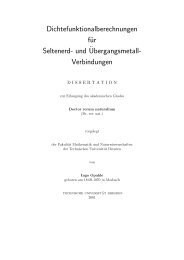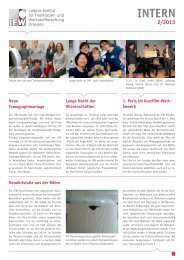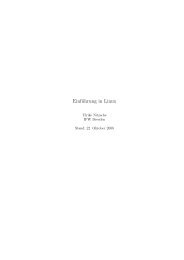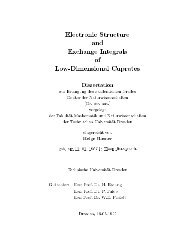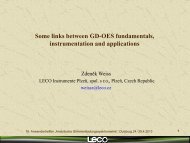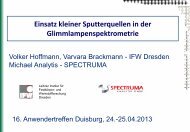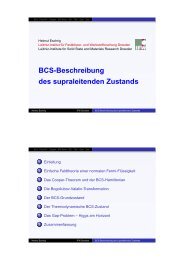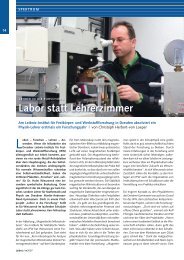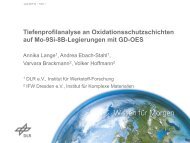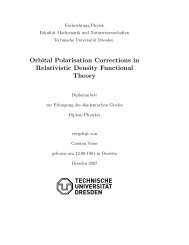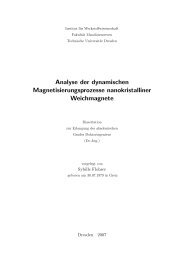ALBERTO BOLLERO REAL
ALBERTO BOLLERO REAL
ALBERTO BOLLERO REAL
Create successful ePaper yourself
Turn your PDF publications into a flip-book with our unique Google optimized e-Paper software.
3.4 Development of exchange-coupled nanocrystalline magnets<br />
Hirosawa et al [56] obtained the critical dimension of about 10 nm for a mutually<br />
coupled Fe 3 B/Nd 2 Fe 14 B mixture with melt-spun (Nd,Dy) x Fe 80.5-x-y Co y B 18.5 M 1 (3 ≤ x ≤ 5 and<br />
0 ≤ y ≤ 5) alloys where M represents additives (Al, Si, Cu, Ga, Ag, Au) used to reduce the<br />
grain size. In this way, a coercivity of 0.6 T and a remanence of 0.98 T were obtained in<br />
Nd 3 Dy 2 Fe 70.5 Co 5 Ga 1 B 18.5 . Ping et al [57] argumented that Co and Ga atoms control the<br />
grain growth of Fe 3 B precipitates and contribute to the formation of the Fe 3 B/Nd 2 Fe 14 B<br />
nanocomposite with ultrafine grains, which leads to a high coercivity and an improved<br />
maximum energy product.<br />
Uehara et al [58] explained how the addition of Cr contributes to the magnetic<br />
properties of these nanocomposite magnets produced by melt-spinning, providing a high<br />
coercivity. This is in good agreement with a previous study performed by Hirosawa and<br />
Kanekiyo [59] on Fe/Nd 2 Fe 14 B nanocomposite magnets produced from melt-spun Nd-Fe-<br />
B-Co-Cr alloys with low-Nd and high-B concentration; they obtained magnetic properties<br />
between (J r ,µ 0 H c ) = (1.20 T, 0.43 T) and (0.86 T, 0.77 T), the large coercivity being due to<br />
a refinement of microstructure and an increase in the volume fraction of the hard magnetic<br />
Nd 2 (Fe,Cr) 14 B phase produced by the partial replacement of Fe by Cr. Bauer et al [60]<br />
studied the relationship between the magnetic properties and the Fe/Nd 2 Fe 14 B volume<br />
ratio, finding that a composite magnet containing 30 vol% bcc-Fe exhibits a maximum<br />
remanence of J r = 1.25 T and an energy product of (BH) max = 185 kJm -3 . Melsheimer et al<br />
[61] compared the magnetic properties of three different Nd-Fe-Co-B magnets produced<br />
also by the melt-spinning procedure: a nanocrystalline exchange-coupled Nd 2 (Fe 1-x Co x ) 14 B<br />
single-phase magnet, Nd 2 (Fe 1-x Co x ) 14 B + (Fe 1-x Co x ) composite magnets and a decoupled<br />
Nd 2 (Fe 1-x Co x ) 14 B magnet with an overstoichiometric Nd content. As it was expected, they<br />
observed an enhanced remanence and a decrease in coercivity for both exchange-coupled<br />
magnets in comparison to the decoupled material. They obtained a uniform grain size (22-<br />
25 nm) for the single phase magnet, and a mixture of very small grains of a soft magnetic<br />
phase (< 20 nm) and small hard magnetic grains ( ≈ 35 nm) for the composite magnet. The<br />
single-phase and the composite magnets exhibited maximum energy products of up to 175<br />
kJm -3 , at T = 300 K, whereas only 93 kJm -3 was obtained for the decoupled magnet. In Fig.<br />
3.6, hysteresis loops of a decoupled and an exchange-coupled magnet with compositions<br />
Nd 15 (Fe 57.5 Co 18.5 )B 9 and Nd 12 (Fe 62 Co 20 )B 6 , respectively, are reproduced from that work.<br />
25



